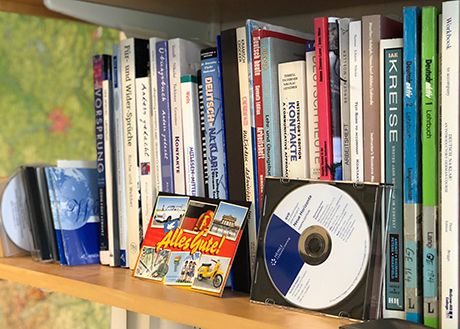In this section, Peter Weise notes there was no textbook available for the kind of course he wanted to teach in 21G.410 Advanced German: Professional Communication. As a result, he designed his own curriculum, turning to authentic language materials to help teach communicative elements of German across a wide variety of professional and research-based settings.
"I use language to explain culture …"
In this course, students read German news, write resumes, and engage with other forms of authentic language materials. I have structured the course like this because there was no textbook for the kind of learning experience I wanted to create in 21G.410 Advanced German: Professional Communication. It’s not a course geared toward professionals in a specific field. There are textbooks for that kind of course. Rather, the materials in this course need to speak to students regardless of whether their major is biology, architecture, urban planning, or physics.

A selection of German language materials in Peter Weise’s office on the MIT campus.
While it’s true that there are textbooks that teach learners how to converse in German business settings, these resources mainly teach how to ask someone if they want a cup of coffee or how to take a telephone message. These are not concerns that MIT graduates, who are researchers, doers, and makers, will have in the workplace. After surveying the existing textbooks on the market, it became clear to me that these curricular materials were not for us. It also became clear to me that in order to attract a large number of students, and in order to serve them well, I needed to design a class that didn’t exist.
I started by thinking about the skills students would need to succeed in professional or research-based settings in Germany. I identified four or five essential units of study and then looked for authentic materials to help me develop the specific language skills associated with those units. I turned to authentic materials because it’s much easier for students to learn language through content they find relevant and engaging than it is through textbook materials. When you have interesting content, students don’t even know they’re learning language, because they’re so into it. That’s what this class is about.
In particular, we use authentic materials to examine communicative elements of German. One example is that Germans love the passive voice. When you write professionally in English, people tell you not to use the passive voice. But Germans love it! Why? Because it’s impersonal. If text is impersonal, it sounds more objective, and if it’s more objective, it’s more authoritative. Whatever you’re claiming sounds much more right in the passive voice. Germans use that to their advantage.
Another example is that Germans have a deep affection for nouns. They relish them because they are more fixed, more solid, than verbs. Germans will turn a verb into a noun if at all possible. Doing so makes their writing sound grander and more powerful. This is especially relevant for German curriculum vitae, which are much more concise than their English language counterparts. They are almost like tables with facts. There is very little text about what people do, and when there is description, it is often conveyed through nouns, such that actions are seen as immutable things. This seemingly small grammatical feature is actually a cultural nuance. In the class, I use language to explain culture, to explain that this is what works for Germans and that this is what they will expect students to do in their professional settings. There is no textbook for that.








